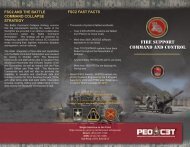2012 Annual Report to the Stakeholders - PEO C3T - U.S. Army
2012 Annual Report to the Stakeholders - PEO C3T - U.S. Army
2012 Annual Report to the Stakeholders - PEO C3T - U.S. Army
You also want an ePaper? Increase the reach of your titles
YUMPU automatically turns print PDFs into web optimized ePapers that Google loves.
<strong>2012</strong> annual report <strong>to</strong> <strong>the</strong> stakeholders<br />
JcR-log pRovideS two-wAy<br />
SituAtionAl AwAReneSS<br />
<strong>to</strong> logiSticiAnS<br />
When Sgt. Jorge Gutierrez first encountered<br />
Joint Capabilities Release-<br />
Logistics (JCR-Log), he was excited by<br />
what he saw.<br />
JCR-Log is <strong>the</strong> <strong>Army</strong>’s next generation<br />
of Movement Tracking System (MTS)<br />
software, which integrates Force XXI<br />
Battle Command Brigade-and-Below<br />
(FBCB2)/Blue Force Tracking (BFT)<br />
capability <strong>to</strong> provide a common picture<br />
of maneuver and logistics units on <strong>the</strong><br />
battlefield.<br />
“I have experience using Blue Force<br />
Tracking from my first deployment <strong>to</strong> Iraq<br />
and using Movement Tracking System<br />
during my second deployment <strong>to</strong> Afghanistan,”<br />
said Gutierrez, 49th Transportation<br />
Battalion, 4th Sustainment Brigade,<br />
13th Sustainment Command, Fort hood,<br />
Texas. “This will be a simple transition<br />
because MTS JCR-Log now has a simple<br />
interface like BFT.”<br />
MTS is a vehicle-based system that<br />
tracks combat support and combat service<br />
support (CS/CSS) vehicles and o<strong>the</strong>r<br />
assets. It offers a Radio Frequency Identification<br />
(RFID) capability <strong>to</strong> provide intransit,<br />
real-time visibility of critical cargo.<br />
Its newest version of software, JCR-Log,<br />
can communicate with and track tactical<br />
wheeled vehicles and cargo in near real<br />
time, enabling <strong>the</strong> safe and timely completion<br />
of distribution missions in support<br />
of unified land operations. The upgraded<br />
capabilities result in a seamless, two-way<br />
situational awareness (SA) and message<br />
exchange between convoys and <strong>the</strong> maneuver<br />
formations <strong>to</strong> which <strong>the</strong>y are delivering<br />
goods.<br />
“This is <strong>the</strong> first time ever that support<br />
units can see shooters and shooters can<br />
see support units,” said Lt. Col. Robert<br />
Middle<strong>to</strong>n, product direc<strong>to</strong>r (PD) for MTS.<br />
“Two-way situational awareness is a key<br />
attribute of JCR-Log.”<br />
MTS-JCR-Log will operate on <strong>the</strong><br />
FBCB2/BFT network, which allows both<br />
FBCB2/BFT and MTS <strong>to</strong> converge <strong>to</strong> a<br />
single network system, resulting in efficiencies<br />
in equipment, maintenance and<br />
sustainment. These transitions occurred<br />
after PD MTS moved from Program Executive<br />
Office for Enterprise Information<br />
Systems <strong>to</strong> Program Executive Office for<br />
Command, Control and Communications<br />
- Tactical.<br />
In addition, JCR-Log possesses a<br />
powerful map engine that uses military<br />
symbology and satellite imagery; as well<br />
as an extensive list of preformatted messages<br />
such as nuclear, biological, and<br />
chemical, SPOT reports, and logistics reports.<br />
It also includes a more user-friendly<br />
and familiar graphical user interface.<br />
JCR-Log will provide CS/CSS Soldiers<br />
with full situational awareness across <strong>the</strong><br />
<strong>the</strong>ater of operations and a common operating<br />
picture with maneuver elements.<br />
An FBCB2/BFT/MTS team began<br />
fielding JCR/JCR-Log <strong>to</strong> <strong>the</strong> Eighth U.S.<br />
<strong>Army</strong> in Korea in January. PD MTS<br />
fielded JCR-Log <strong>to</strong> units at Fort Bragg,<br />
N.C.; Fort Bliss, Texas; Fort Riley, Kan.;<br />
Fort Drum, N.y.; and Fort Polk, La.; in<br />
May <strong>2012</strong>.<br />
There are cost savings as-<br />
sociated with moving MTS <strong>to</strong><br />
JCR-Log software, according <strong>to</strong><br />
Peter Nguyen, project lead for <strong>the</strong><br />
Project Manager FBCB2 Technical<br />
Management Division. The entire<br />
JCR user family can share <strong>the</strong> network<br />
and share bandwidth.<br />
“JCR-Log shares <strong>the</strong> same hardware<br />
and same computer as FBCB2,” Nguyen<br />
explained. “Also, <strong>the</strong> JCR field support<br />
representative team can support <strong>the</strong> platform.<br />
There will be savings associated<br />
with training, <strong>to</strong>o, since we can use <strong>the</strong><br />
same trainer for JCR as for JCR-Log.”<br />
MTS<br />
transition<br />
<strong>to</strong> FBCB2 has an<br />
estimated cost savings<br />
of $14 million per year<br />
in satellite service<br />
beginning in<br />
Program ExEcutivE officE command control communications-tactical // 25<br />
FY15



